
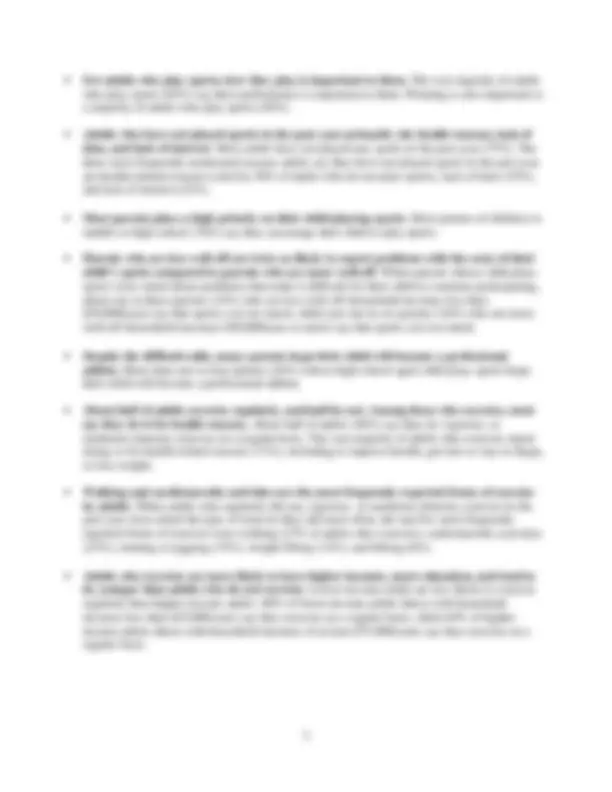
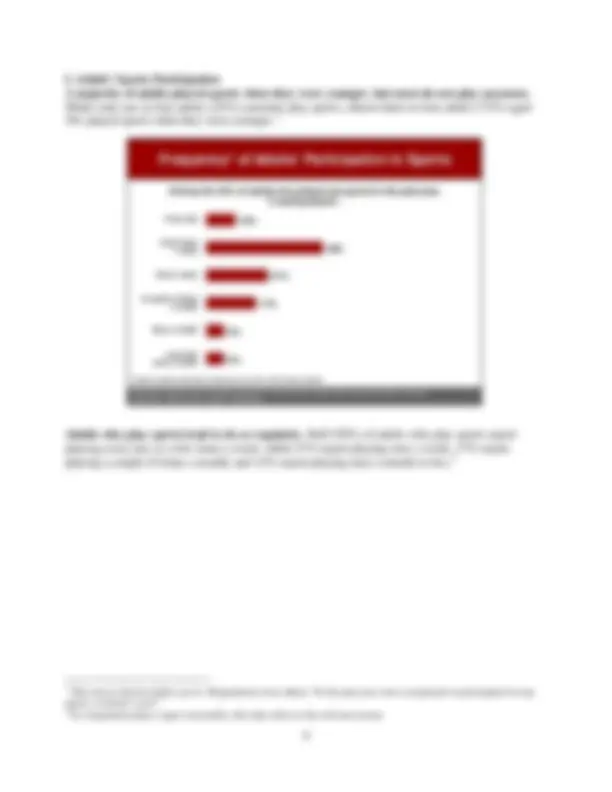

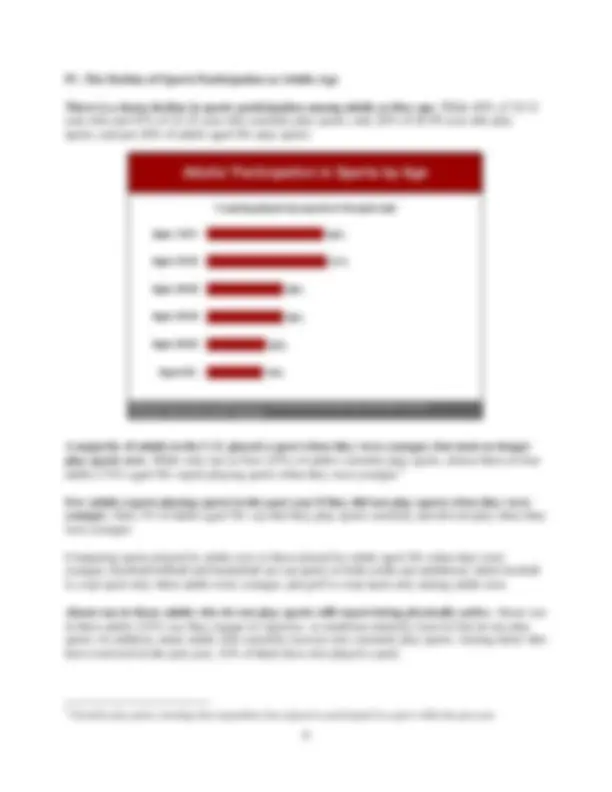

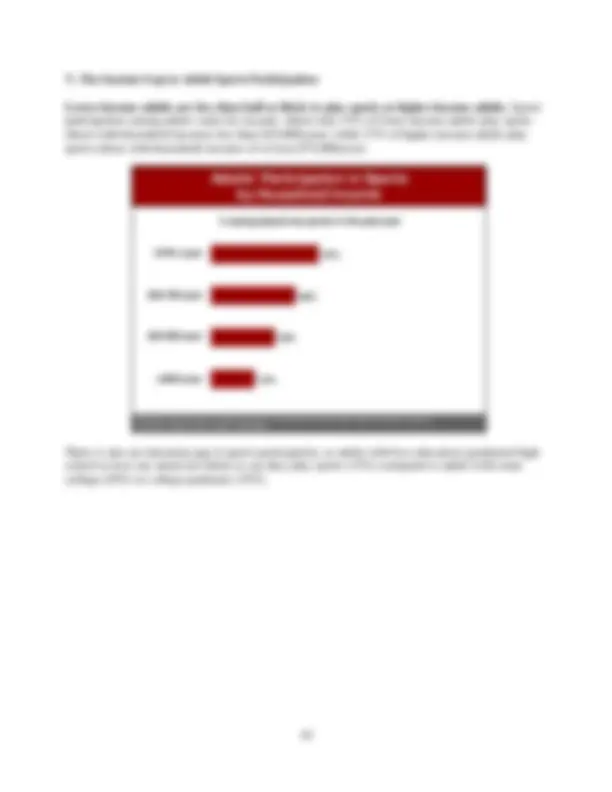



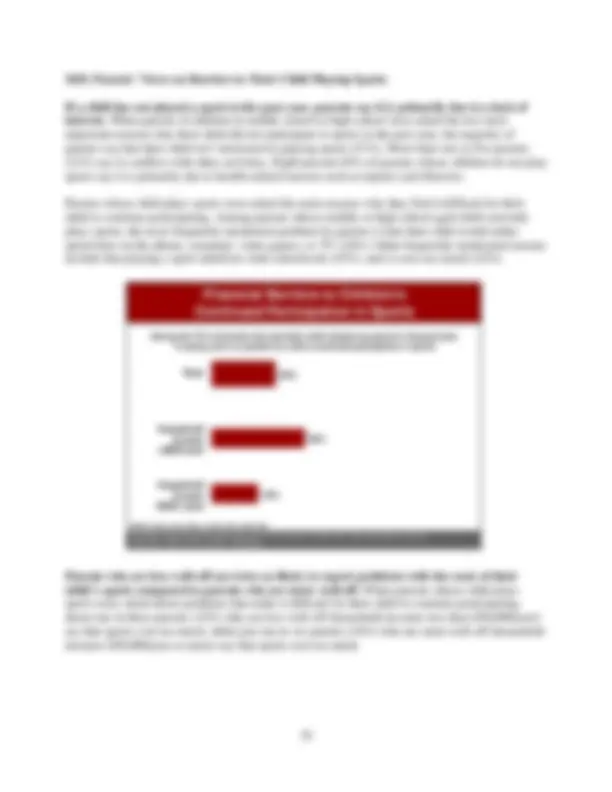

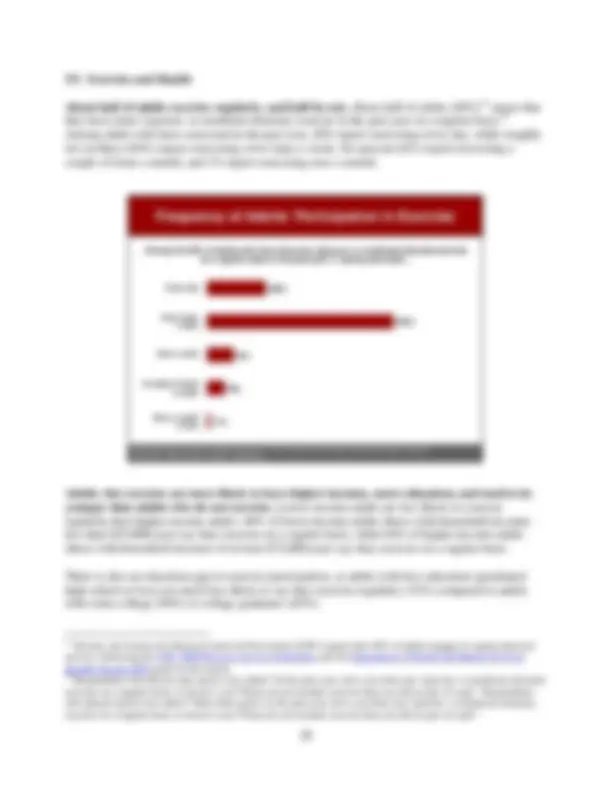
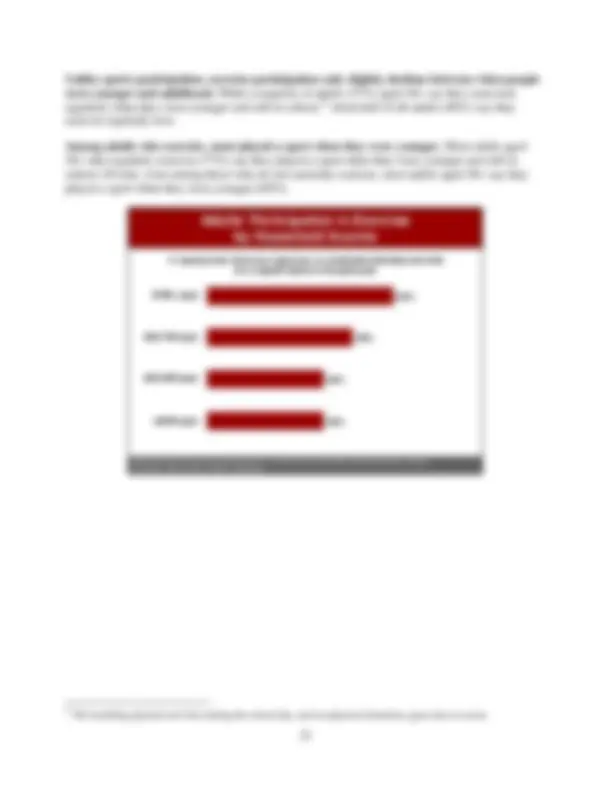
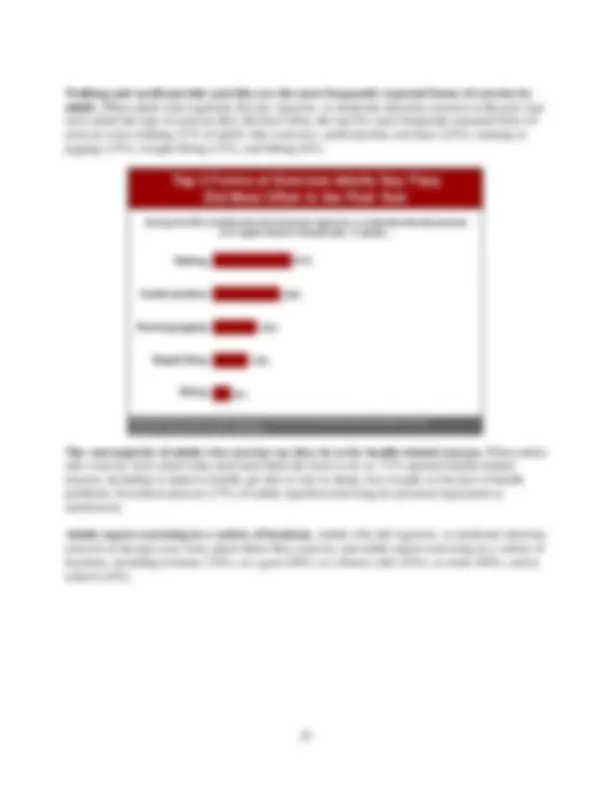


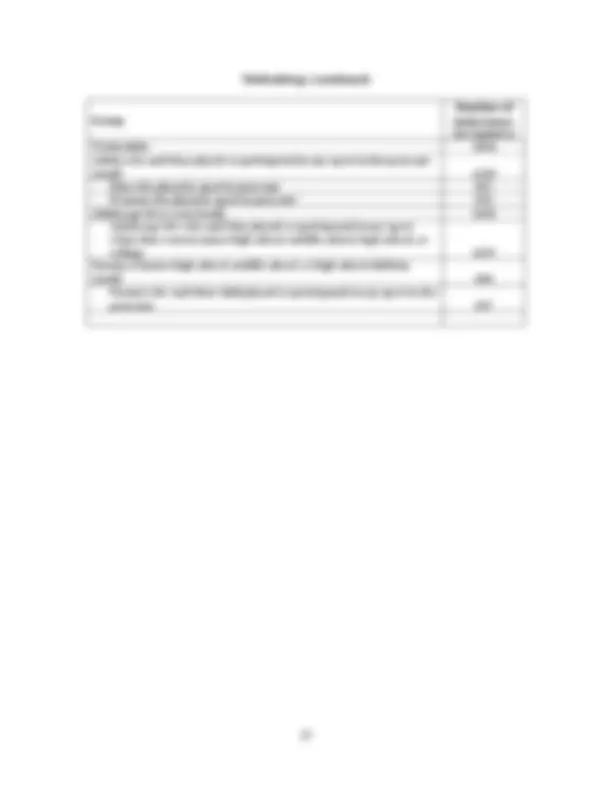
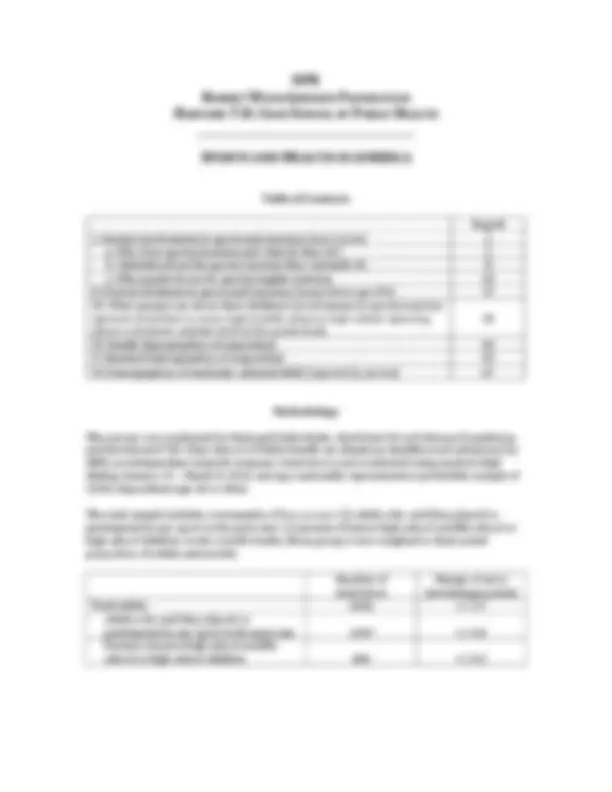
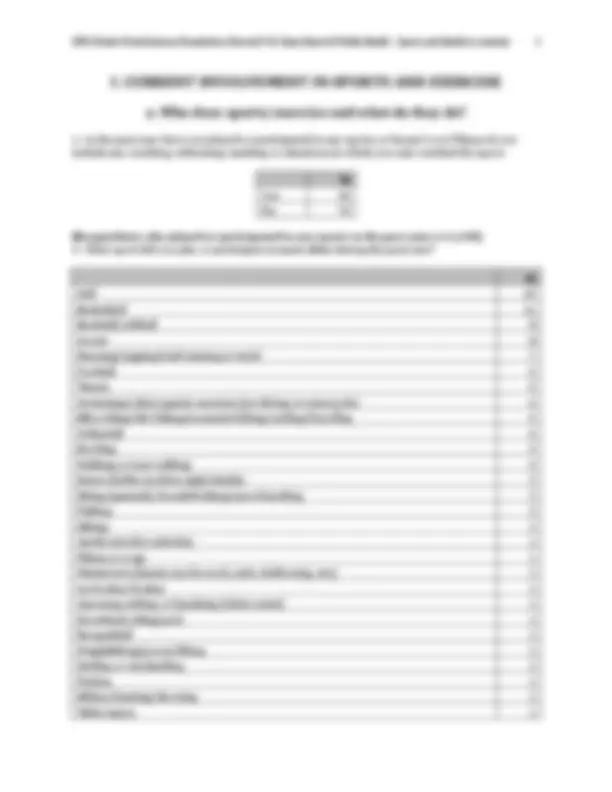
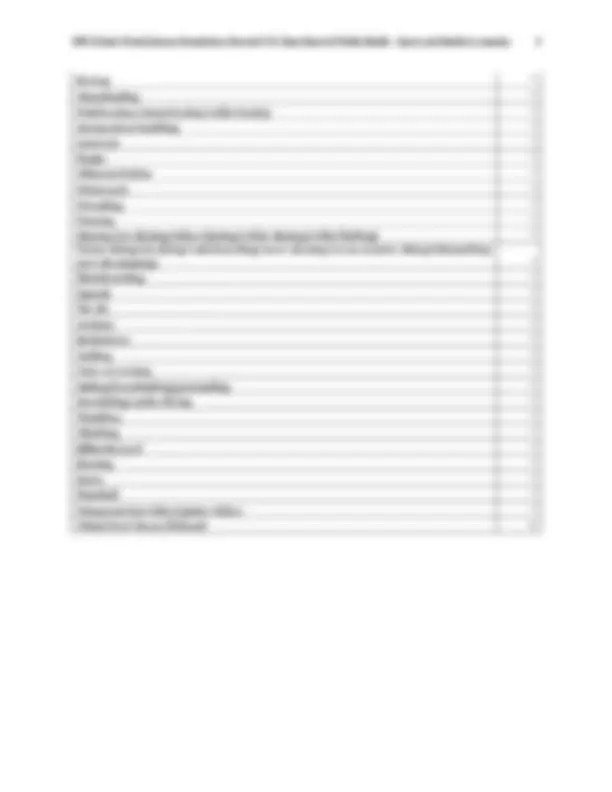

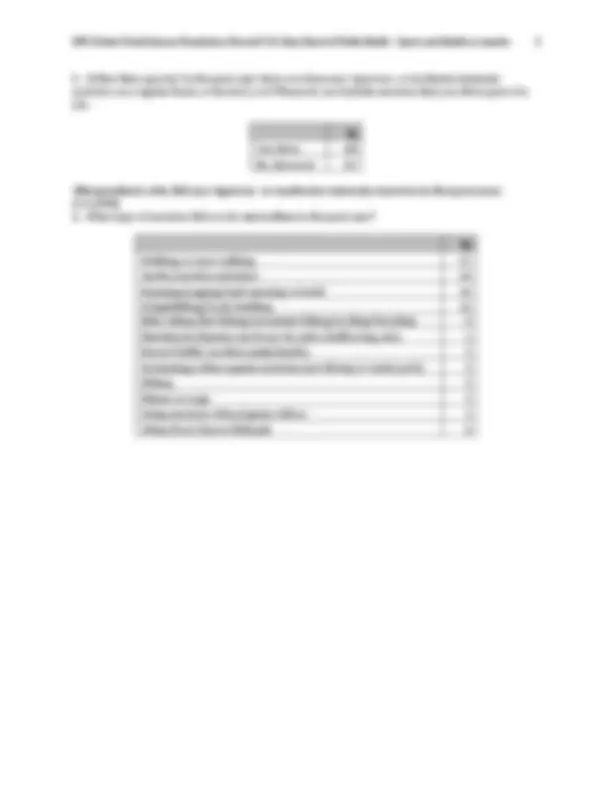
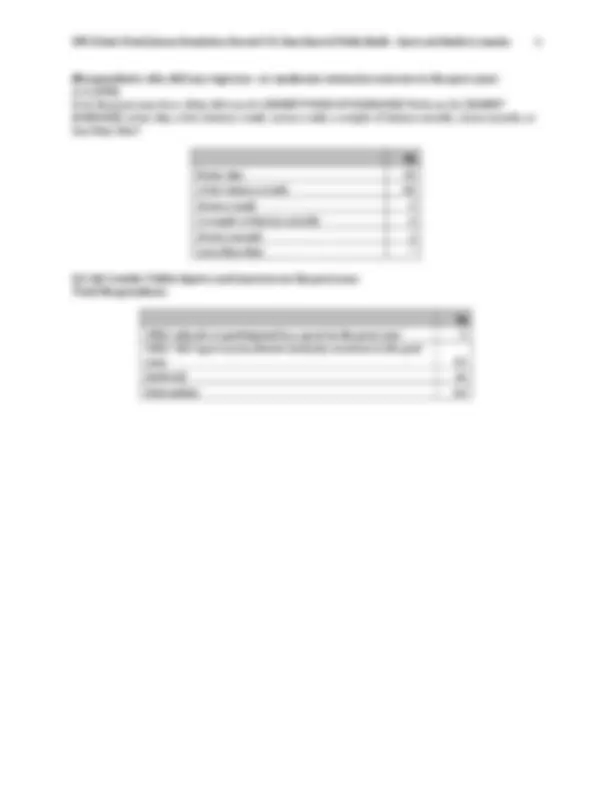
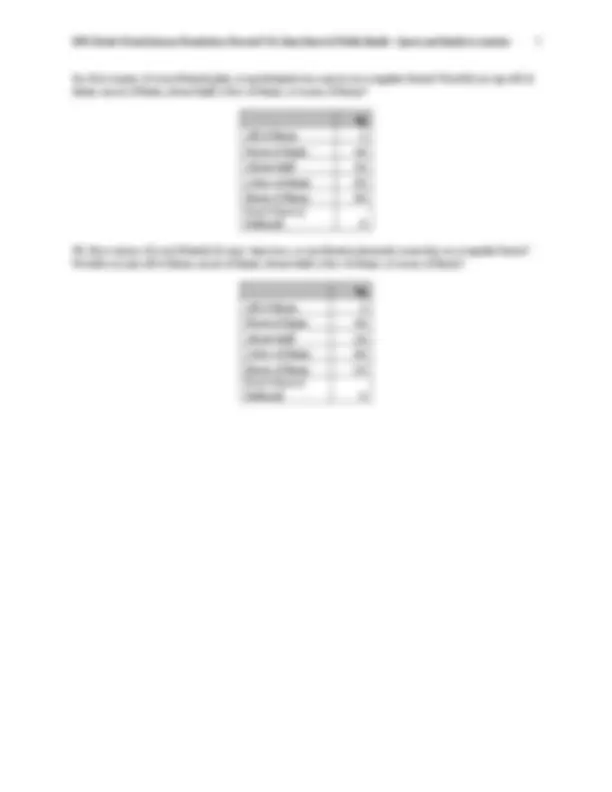
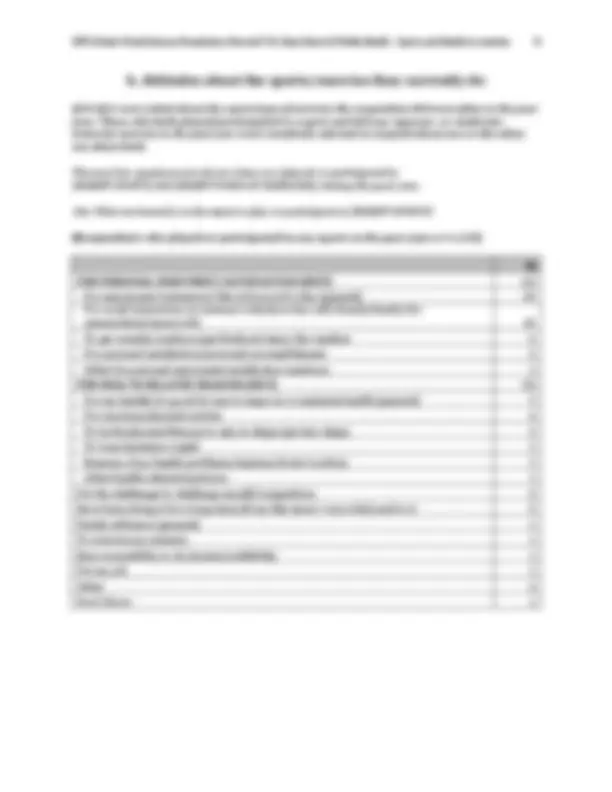
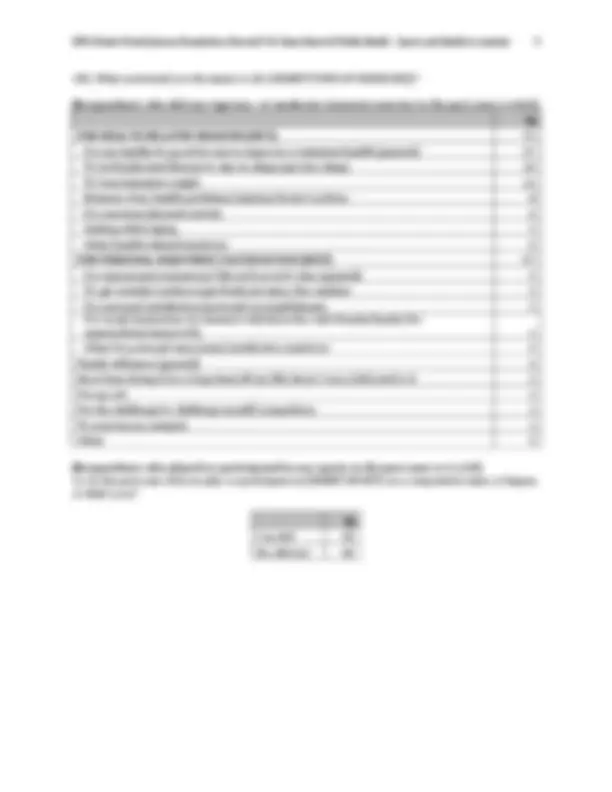
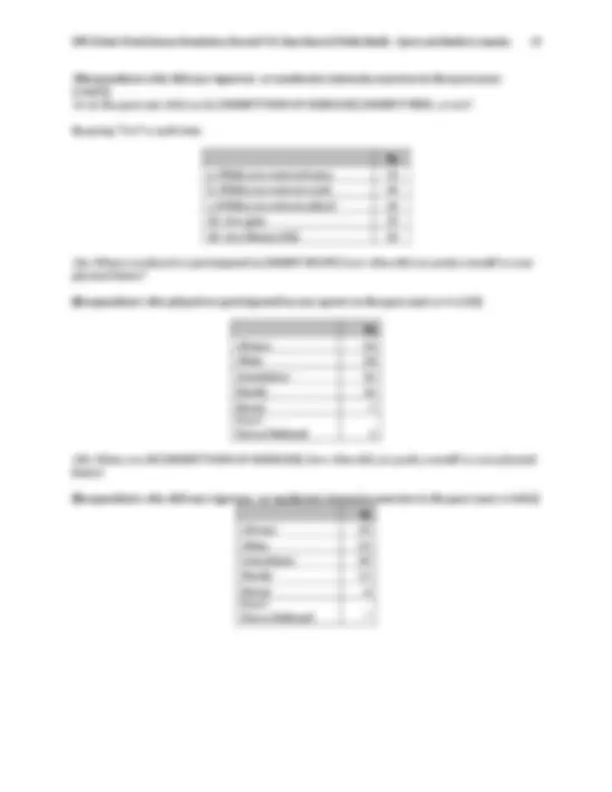
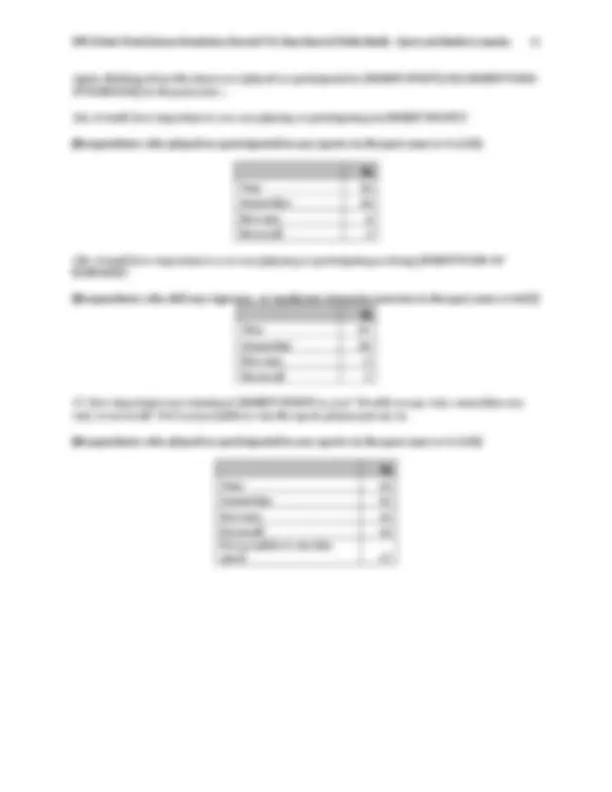
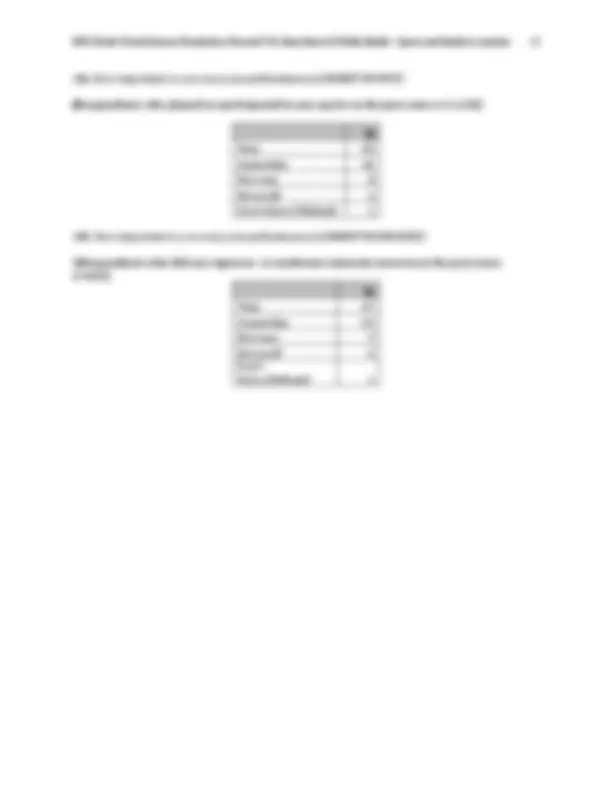
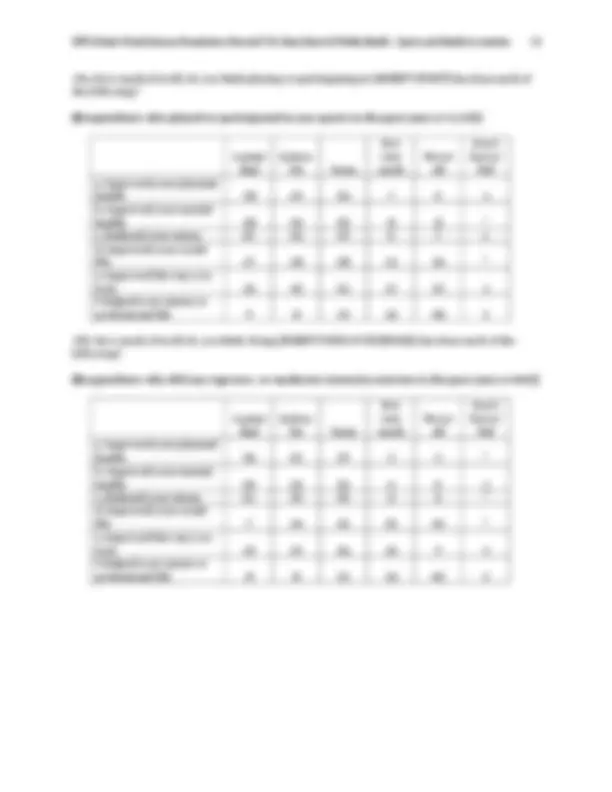

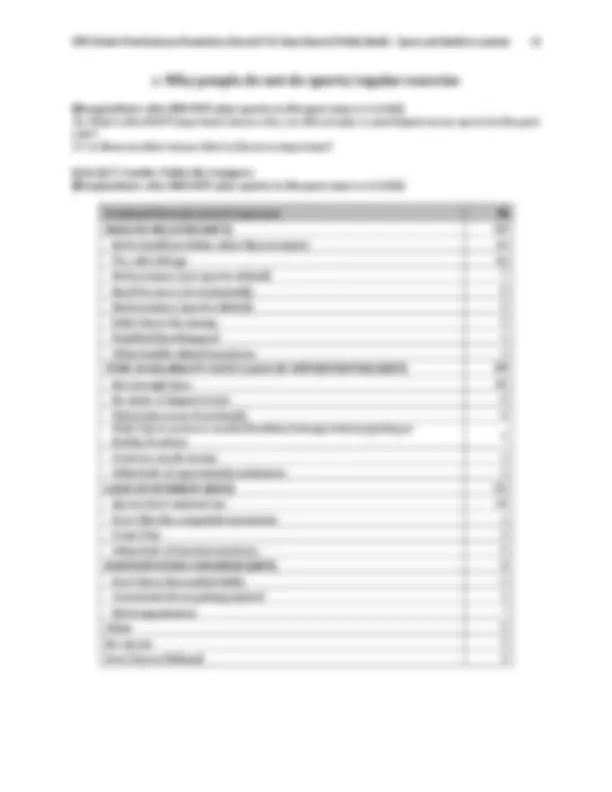
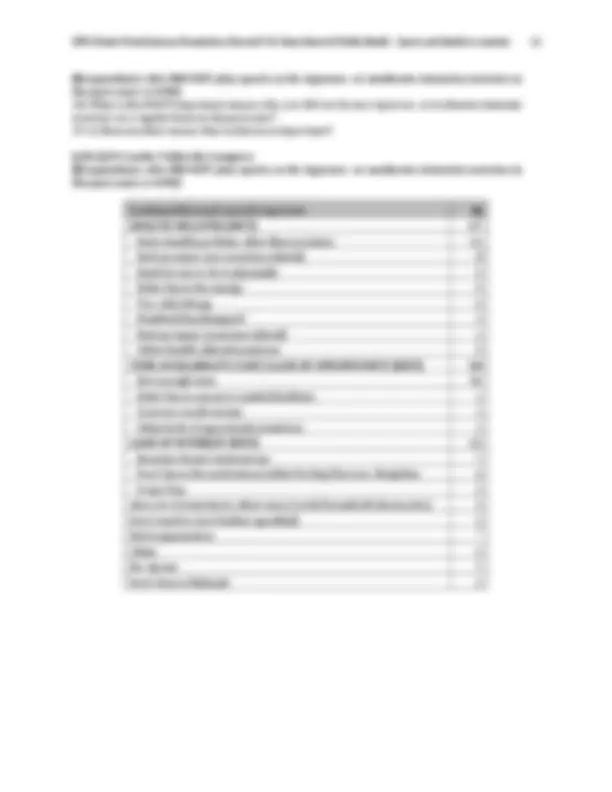
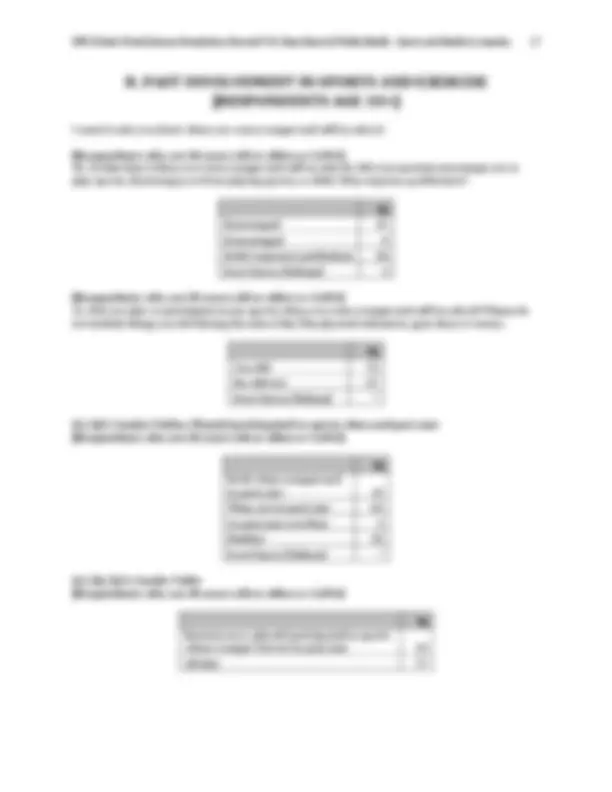
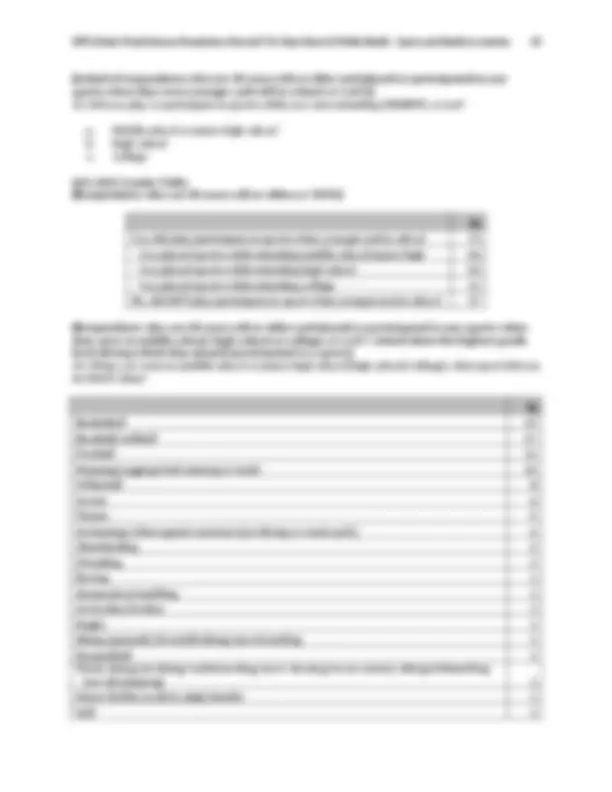
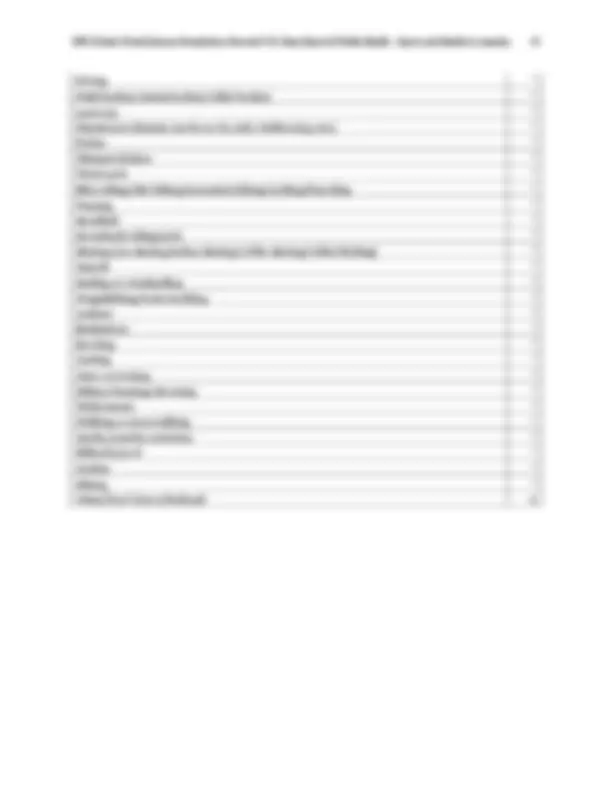
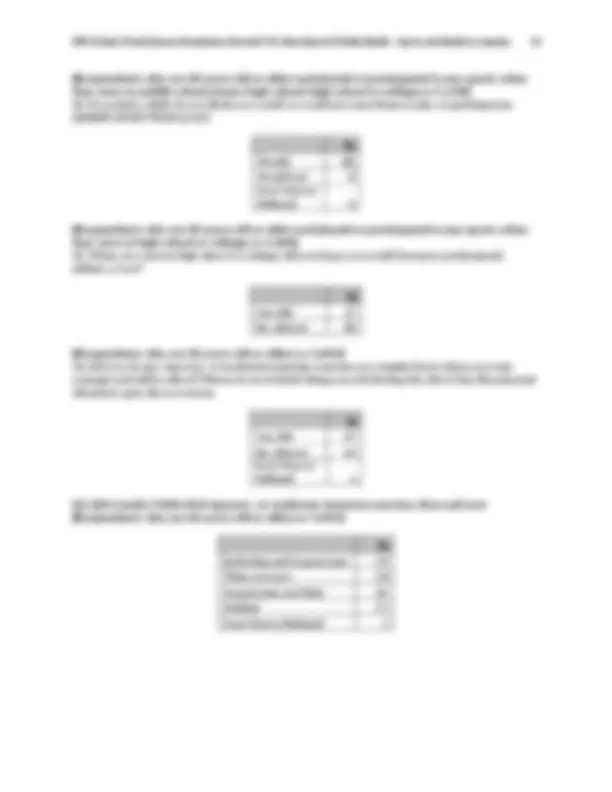
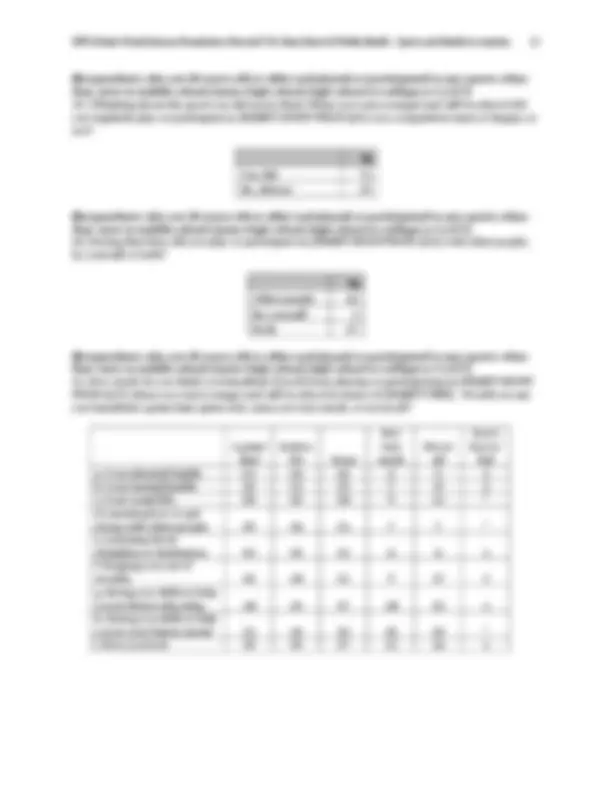
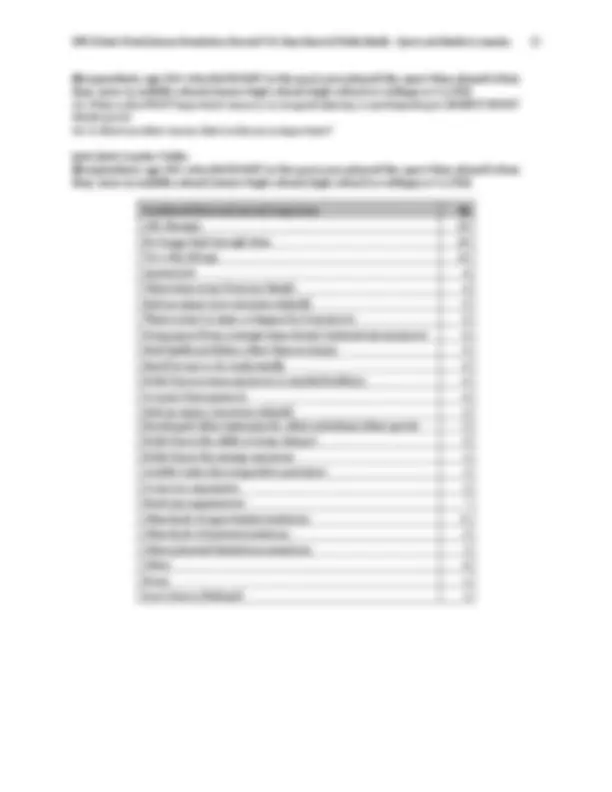


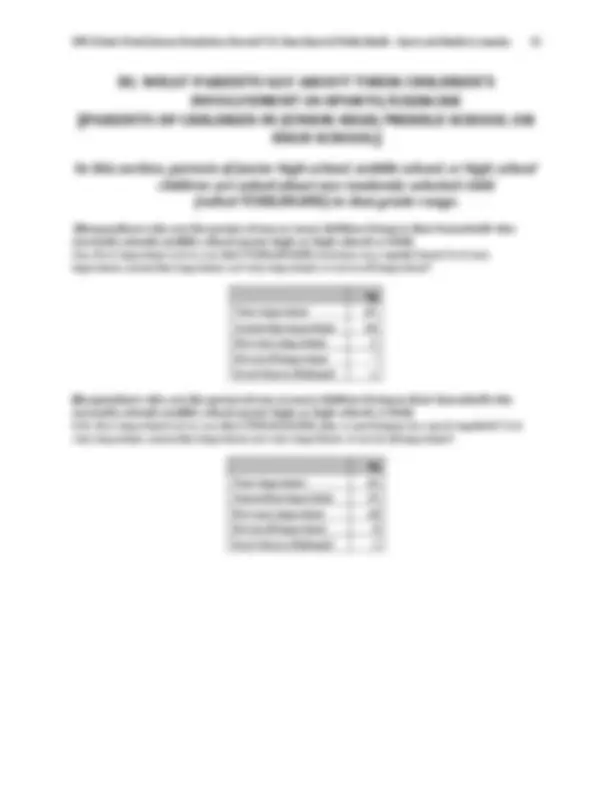
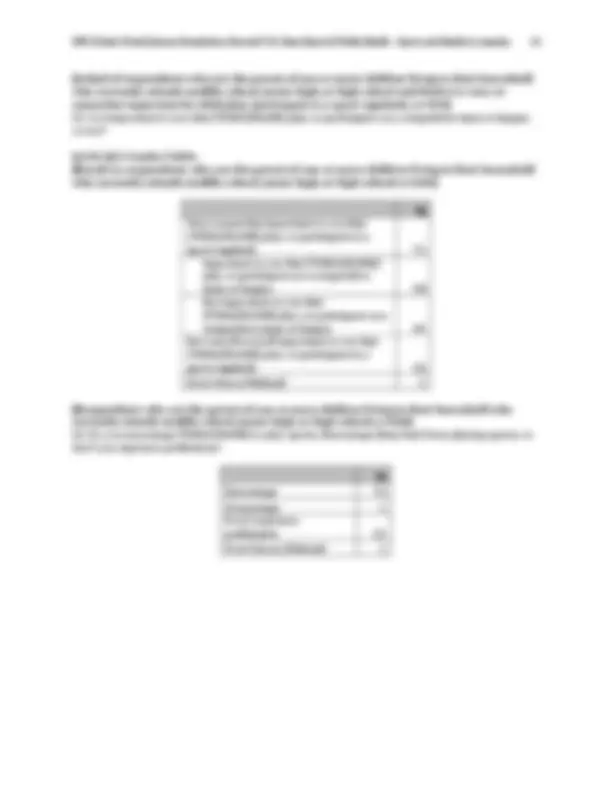
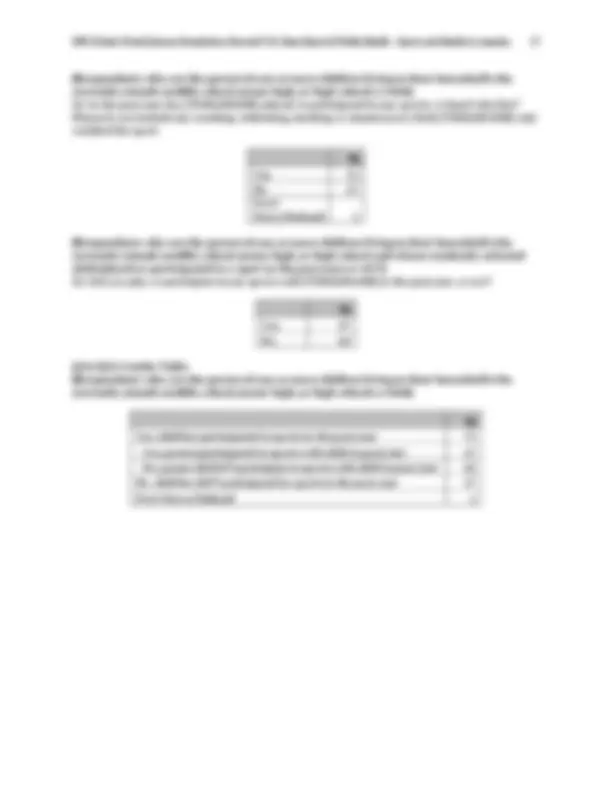
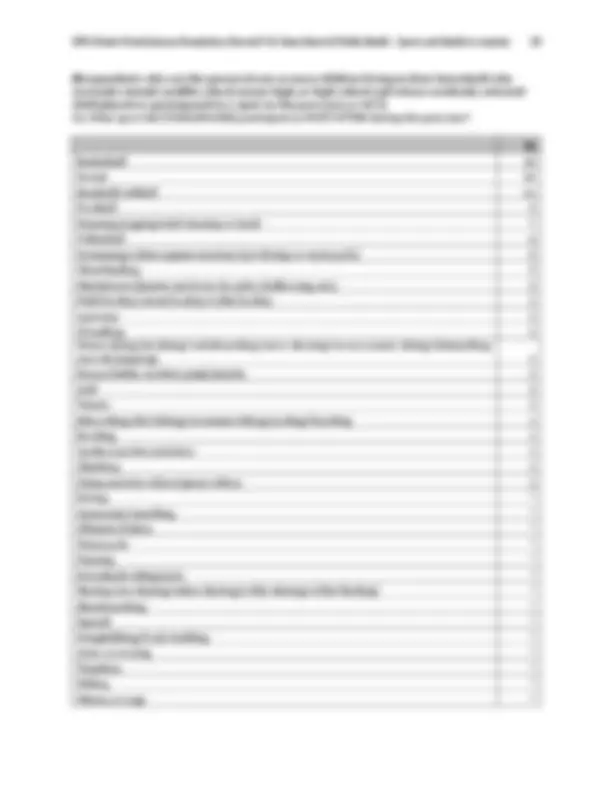

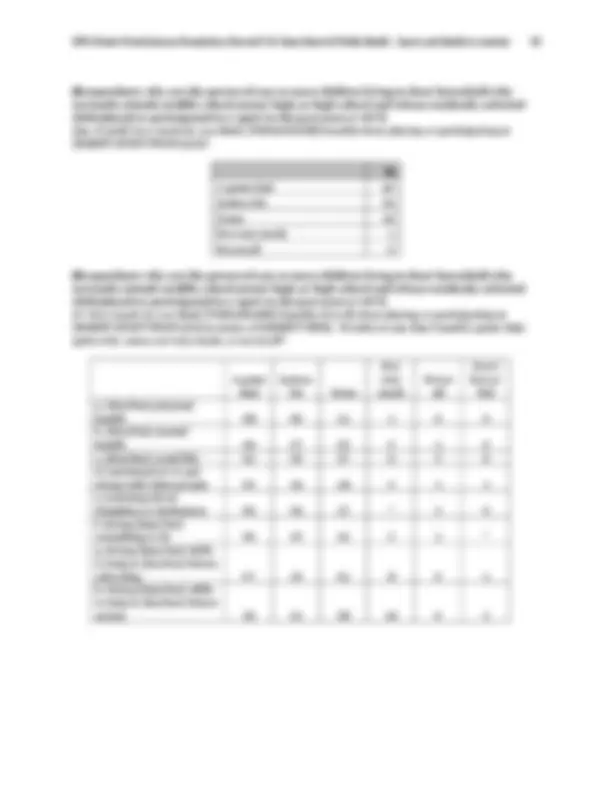
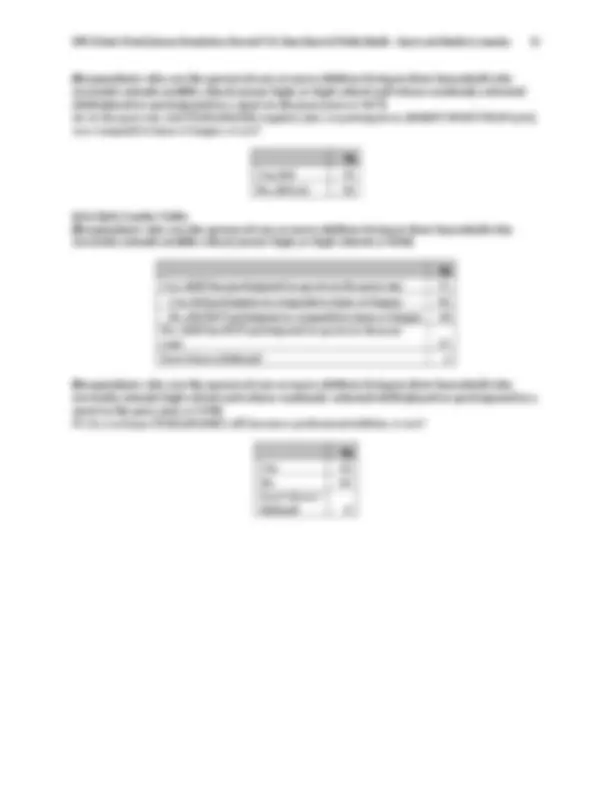
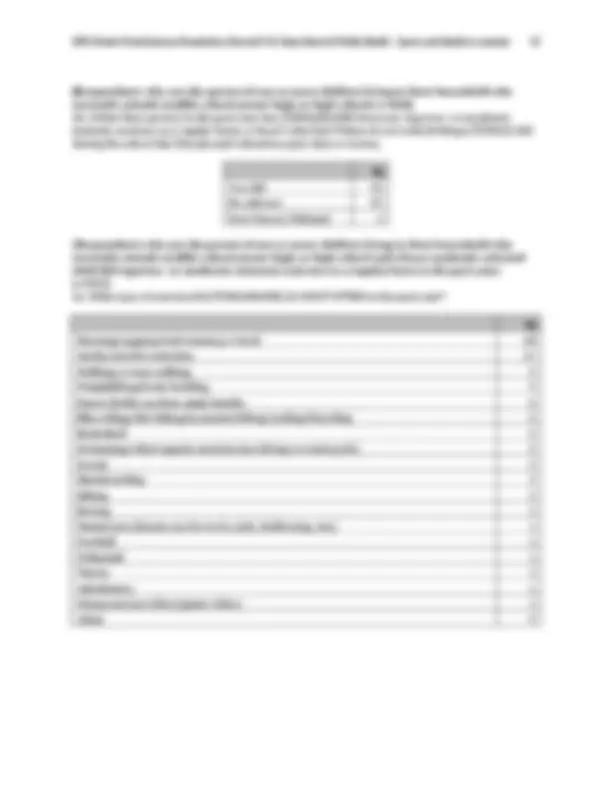

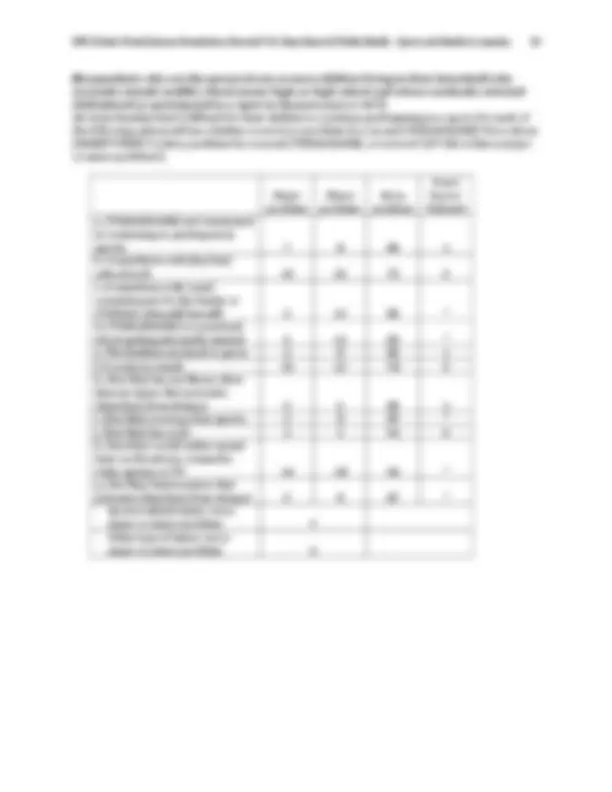
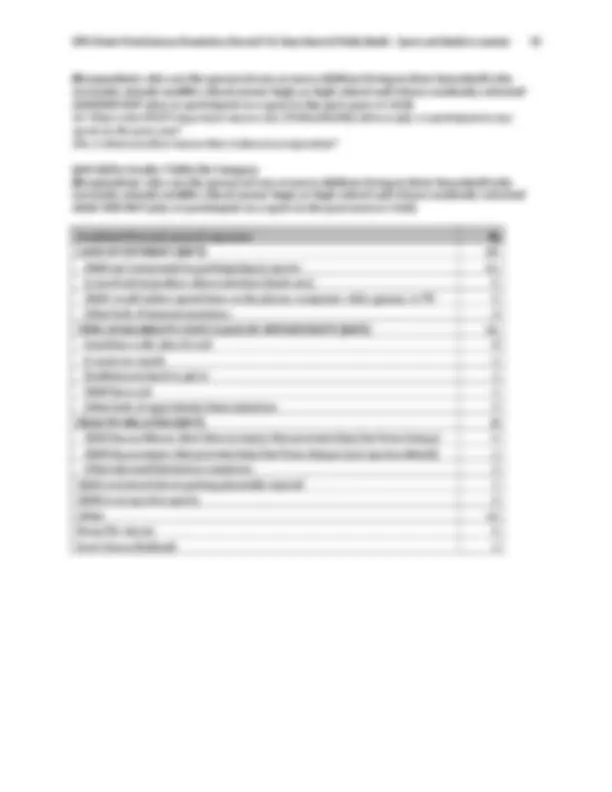

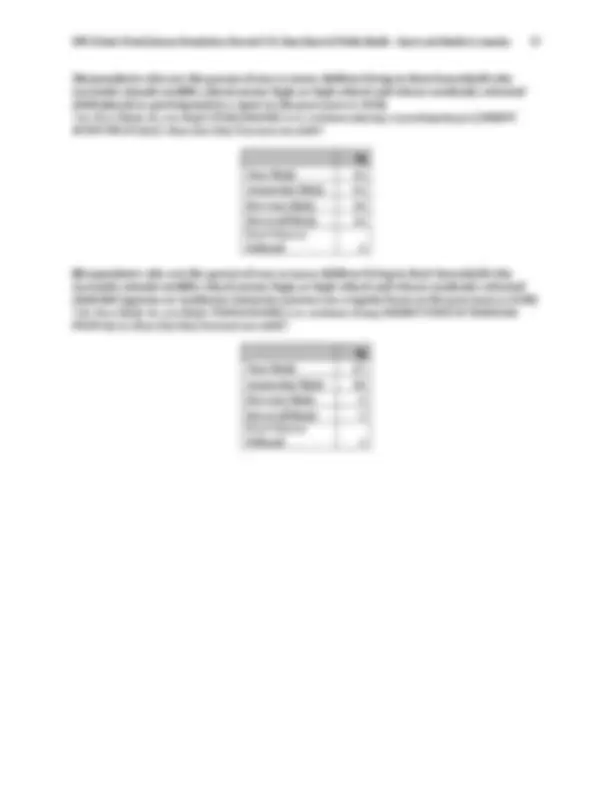

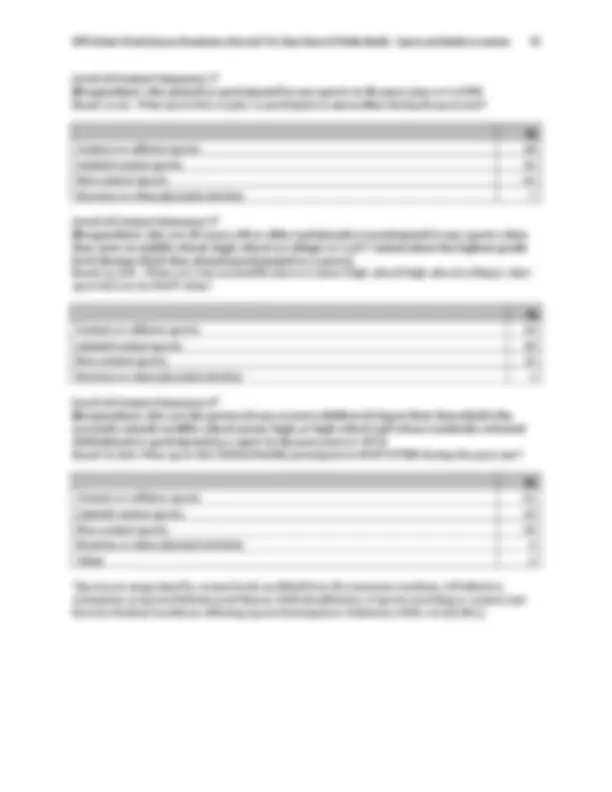
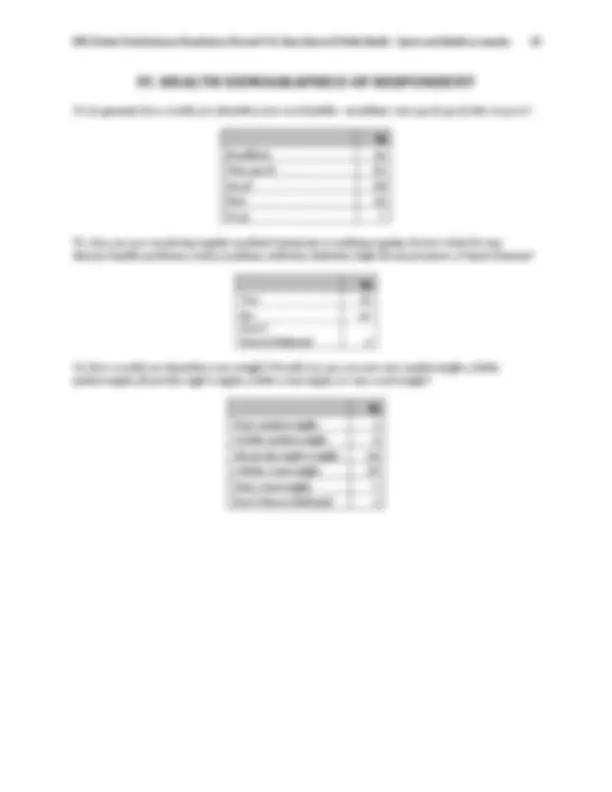
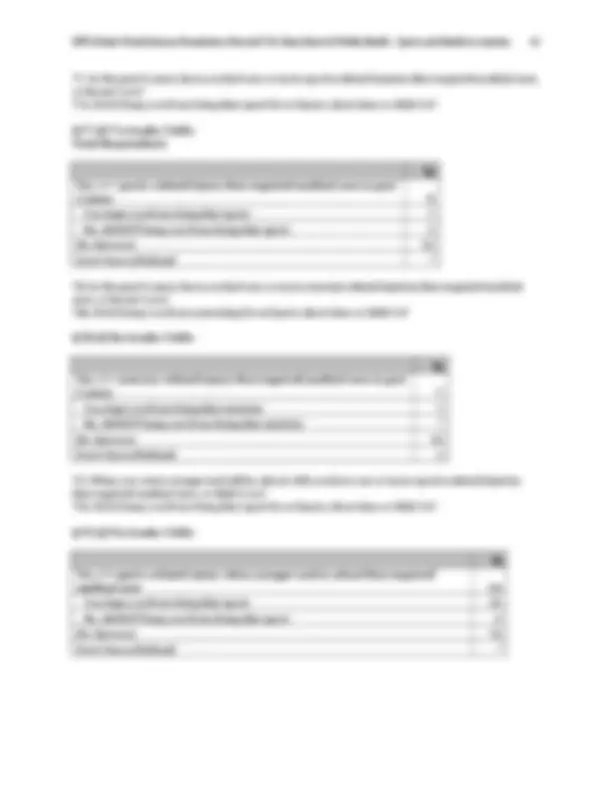
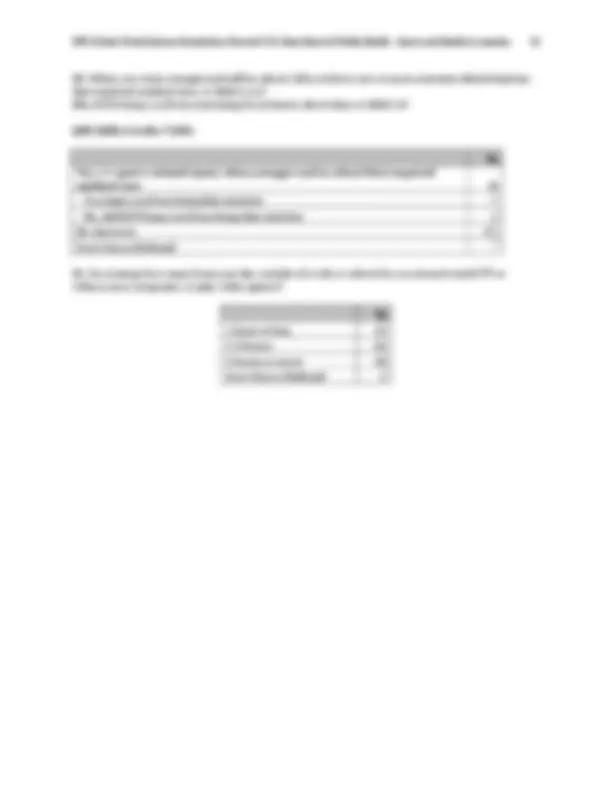
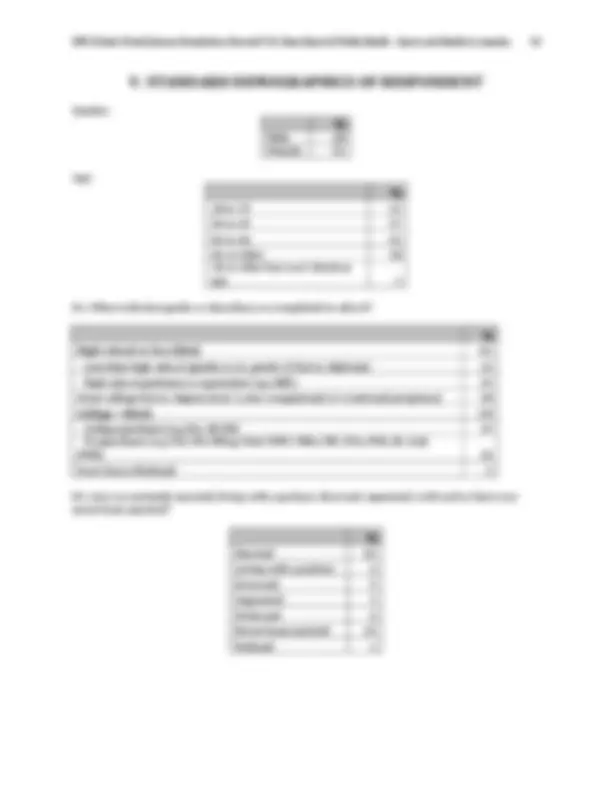
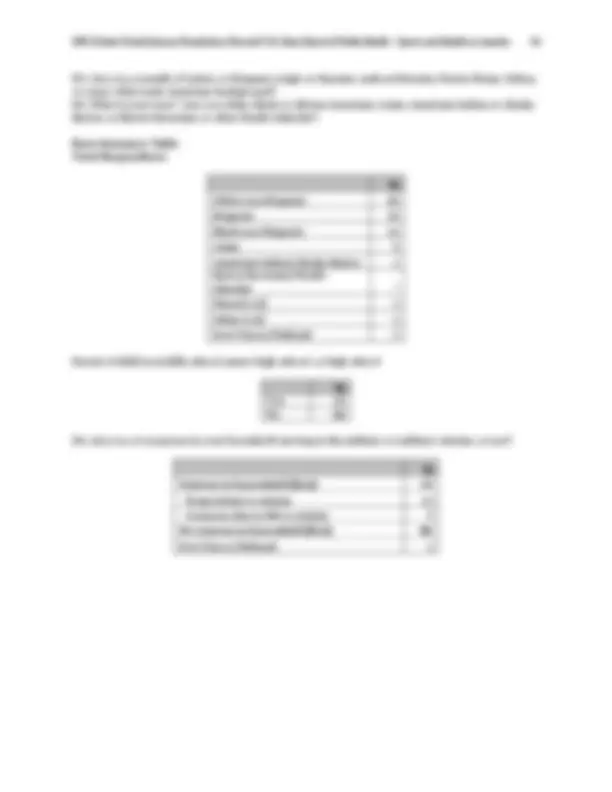



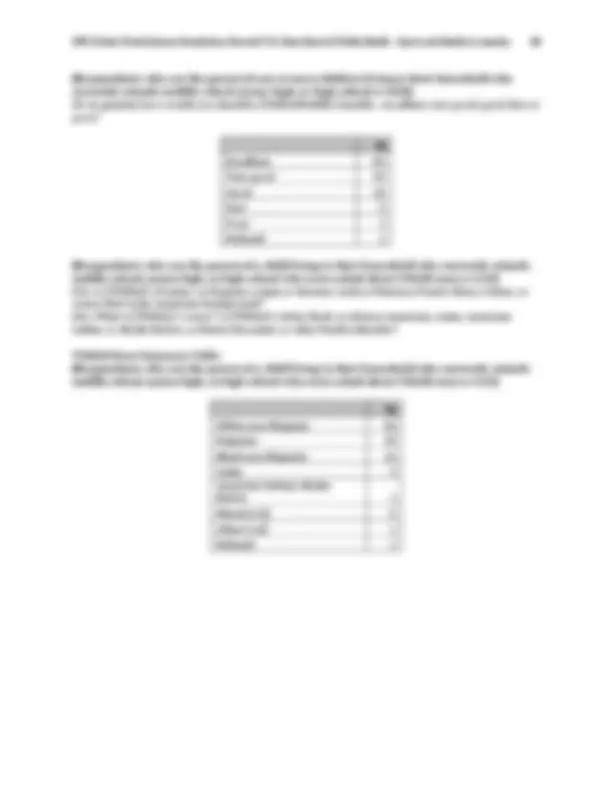


Study with the several resources on Docsity

Earn points by helping other students or get them with a premium plan


Prepare for your exams
Study with the several resources on Docsity

Earn points to download
Earn points by helping other students or get them with a premium plan
Community
Ask the community for help and clear up your study doubts
Discover the best universities in your country according to Docsity users
Free resources
Download our free guides on studying techniques, anxiety management strategies, and thesis advice from Docsity tutors
The top five sports played by girls most often are basketball, baseball/softball, volleyball, soccer, and running or track. • The top two reasons adults say ...
Typology: Lecture notes
1 / 73

This page cannot be seen from the preview
Don't miss anything!


































































A majority of adults played sports when they were younger, but most do not play anymore. While only one in four adults (25%) currently play sports, almost three in four adults (73%) aged 30+ played sports when they were younger.
When asked the sport they play most often, adults report playing more than 50 different types of sports , ranging from hockey and fishing to martial arts and bowling. The top five sports played most often by adults overall are golf, basketball, baseball/softball, soccer, and running or track.
There is a striking gender gap in sports participation among adults. Men are more than twice as likely as women (35% to 16%) to say they play sports. The top five sports played by men most often (including ties) are golf, basketball, soccer, baseball/softball, football, and running or track. The top five sports played by women most often are running or track, baseball/softball, tennis, volleyball, and swimming.
This gender gap does not exist among children. Parents of middle school or high school aged children report that most boys and girls (76% and 70%) currently play sports.
There is a sharp decline in sports participation among adults as they age. While 40% of 18- 21 year olds and 41% of 22-25 year olds currently play sports, only 26% of 26-49 year olds play sports, and just 20% of adults aged 50+ play sports.
Lower-income adults are less than half as likely to play sports as higher-income adults. Sports participation among adults varies by income, where only 15% of lower-income adults play sports (those with household incomes less than $25,000/year), while 37% of higher-income adults play sports (those with household incomes of at least $75,000/year).
Parents report that their children also participate in a wide range of sports, ranging from field hockey and wrestling to volleyball and lacrosse. The top five sports played by boys most often (including ties) are basketball, soccer, football, baseball/softball, swimming, and running or track. The top five sports played by girls most often are basketball, baseball/softball, volleyball, soccer, and running or track.
The top two reasons adults say they play sports are for personal enjoyment and health. A majority of adults who play sports do so for personal enjoyment (55%), while almost one in four (23%) of those who play do so for health-related reasons, including to improve health, to get into or stay in shape, or lose weight.
A majority of adults who play sports say it has improved their health. More than half of adults who play sports report that it has reduced their stress (58%), improved their mental health (54%), or improved their physical health (51%) a great deal or quite a bit. Considering only the top five sports played most often by adults, those who do running or track or play soccer are more likely to say that it has improved their physical health than those who play other sports.
I. Adults’ Sports Participation A majority of adults played sports when they were younger, but most do not play anymore. While only one in four adults (25%) currently play sports, almost three in four adults (73%) aged 30+ played sports when they were younger. 1
Adults who play sports tend to do so regularly. Half (50%) of adults who play sports report playing every day or a few times a week, while 21% report playing once a week, 17% report playing a couple of times a month, and 12% report playing once a month or less.^2
(^1) This survey did not define sports. Respondents were asked, “In the past year, have you played or participated in any
sports, or haven’t you?” (^2) If a respondent plays a sport seasonally, this only refers to the relevant season.
NPR/Robert Wood Johnson Foundation/Harvard T.H. Chan School of Public Health, Sports and Health in America, January 29 – March 8, 2015. Total N = 2506 adults
6%
6%
17%
21%
40%
Every day 10%
A few times a week
Once a week
A couple of times a month
Once a month
Less than once a month
Among the 25% of adults who played any sports in the past year, % saying played…
*If sport is played seasonally, frequencies only refer to the relevant season.
II. Top Sports Among Adults (Most Frequently Played)
When asked the sport they play most often, adults report playing more than 50 different types of sports , ranging from hockey and fishing to martial arts and bowling. No single sport is played most often by 15% of adults who play sports. While the top five sports played most often by adults overall^3 are golf (13% of sports participants), basketball (11%), baseball/softball (8%), soccer (8%), and running or track (7%), there are significant differences in sports played between men and women, and by adults of different ages.
(^3) Respondents were asked, “What sport did you play or participate in most often during the past year?”
NPR/Robert Wood Johnson Foundation/Harvard T.H. Chan School of Public Health, Sports and Health in America, January 29 – March 8, 2015. Total N = 2506 adults
Total N = 2506 adults
Base: % played/participated in sports, for each group: Men ages 18 ‐ 29 Women ages 18 ‐ 29 48% 23%
1t Basketball 22 1 Baseball/softball 16 1t Soccer 22 2 Volleyball 13 3 Football 13 3 Running/track 12 4 Baseball/softball 6 4 Tennis 11 5 Running/track 5 5 Basketball 9
Base: % played/participated in sports, for each group: Men ages 30 ‐ 49 Women ages 30 ‐ 49 38% 15%
1 Basketball 14 1 Running/track 19 2t Soccer 10 2 Volleyball 11 2t Golf 10 3 Baseball/softball 9 2t Baseball/softball 10 4 Soccer 8 5 Running/track 9 5 Biking 6
Base: % played/participated in sports, for each group: Men ages 50 ‐ 64 Women ages 50 ‐ 64 24% 16%
1 Golf 25 1t Golf 9 2 Baseball/softball 9 1t Walking 9 3 Basketball 8 3t Biking 8 4 Running/track 7 3t Swimming 8 5 Biking 6 5t Tennis 7 5t Dance 7
Base: % played/participated in sports, for each group: Men ages 65+ Women ages 65+ 32% 9%
1 Golf 44 1 Walking 18 2 Basketball 6 2 Swimming 14 3 Baseball/softball 6 3 Golf 13 4t Tennis 4 4 Tennis 11 4t Walking 4 5 Bowling 10 4t Fishing 4
IV. The Decline of Sports Participation as Adults Age
There is a sharp decline in sports participation among adults as they age. While 40% of 18- year olds and 41% of 22-25 year olds currently play sports, only 26% of 26-49 year olds play sports, and just 20% of adults aged 50+ play sports.
A majority of adults in the U.S. played a sport when they were younger, but most no longer play sports now. While only one in four (25%) of adults currently play sports, almost three in four adults (73%) aged 30+ report playing sports when they were younger.^5
Few adults report playing sports in the past year if they did not play sports when they were younger. Only 3% of adults aged 30+ say that they play sports currently and did not play when they were younger.
Comparing sports played by adults now to those played by adults aged 30+ when they were younger, baseball/softball and basketball are top sports in both youth and adulthood, while football is a top sport only when adults were younger, and golf is a top sport only among adults now.
About one in three adults who do not play sports still report being physically active. About one in three adults (32%) say they engage in vigorous- or moderate-intensity exercise but do not play sports. In addition, many adults who currently exercise also currently play sports. Among those who have exercised in the past year, 32% of them have also played a sport.
(^5) Currently play sports, meaning that respondents have played or participated in a sport within the past year.
NPR/Robert Wood Johnson Foundation/Harvard T.H. Chan School of Public Health, Sports and Health in America, January 29 – March 8, 2015. Total N = 2506 adults
19%
20%
26%
26%
41%
Ages 18-21 40%
Ages 22-
Ages 26-
Ages 30-
Ages 50-
Ages 65+
% saying played any sports in the past year
V. The Income Gap in Adult Sports Participation
Lower-income adults are less than half as likely to play sports as higher-income adults. Sports participation among adults varies by income, where only 15% of lower-income adults play sports (those with household incomes less than $25,000/year), while 37% of higher-income adults play sports (those with household incomes of at least $75,000/year).
There is also an education gap in sports participation, as adults with less education (graduated high school or less) are much less likely to say they play sports (15%) compared to adults with some college (29%) or college graduates (35%).
NPR/Robert Wood Johnson Foundation/Harvard T.H. Chan School of Public Health, Sports and Health in America, January 29 – March 8, 2015. Total N = 2506 adults
% saying played any sports in the past year
15%
22%
29%
$75K+/year 37%
$50-75K/year
$25-50K/year
<$25K/year
VI. Why Adults Play Sports
The top two reasons adults say they play sports are for personal enjoyment and health. When adults who play sports were asked what motivated them the most^6 to play the sport they played most often in the past year, a majority (55%) say they do so for reasons related to personal enjoyment and satisfaction, including that sports are fun, they love it, they do it for personal accomplishment, and for social interaction with teammates. Almost one in four adults (23%) who play sports do it primarily for health-related reasons, including maintaining or improving health, to lose weight, and to stay in shape.
Adults report that playing or participating in sports has improved their well-being in a variety of ways. More than half of adults who play sports report that it has reduced their stress (58%), improved their mental health (54%), or improved their physical health (51%) a great deal or quite a bit. Considering only the top five sports played most often by adults, those who do running or track (83%) or play soccer (72%) are more likely to say that it has improved their physical health than those who play other sports.
In addition, about one in three (35%) adults who play sports say that it has improved their social life a great deal or quite a bit, while 29% say it has improved to way they look, and 17% say it has helped their careers or professional lives.
(^6) These numbers reflect an aggregate of the top 2 reasons respondents report playing sports
NPR/Robert Wood Johnson Foundation/Harvard T.H. Chan School of Public Health, Sports and Health in America, January 29 – March 8, 2015. Total N = 2506 adults
17%
29%
35%
51%
54%
58%
Reduced their stress
Among the 25% of adults who played any sports in the past year, % saying they benefited ‘a great deal’ or ‘quite a bit’ in the following ways:
Improved their mental health
Improved their physical health
Improved their social life
Improved the way they look
Helped their career or professional life
VIII. Barriers to Playing Sports Among Adults
Adults who have not played sports in the past year primarily cite health reasons, lack of time, and lack of interest. Most adults have not played any sports in the past year (75%). The three most frequently mentioned reasons adults say they have not played sports in the past year are health- related reasons (cited by 50% of adults who do not play sports), lack of time (35%), and lack of interest (22%). Adults cited multiple health-related reasons for not participating in sports, including that they had a health problem other than an injury (16%), they were too old (16%), had a sports- related injury (2%) or other injury (7%), or sports were hard for them to do physically (5%).
The reasons that adults do not play sports are similar to the reasons why they stop playing sports they participated in when they were younger. When adults aged 30+ were asked why they stopped playing the sport they played when they were younger, the top reasons they stopped are due to life changes (25%), no longer had enough time (20%), and old age (12%). Most adults (69% of those aged 30+) do not regret no longer playing the sports they played when they were younger, but three in ten (30%) do regret no longer playing sports.
IX. Youth Sports Participation
Most young people currently play sports, and there is no gender gap in sports participation among young people today. When parents of middle school or high school aged children were asked what sports their child plays,^8 they reported that most young people (72%) currently play sports in various locations. 9 There is no gender gap in current sports participation between boys and girls (76% and 70%).
The sports that young people play now are somewhat different than the sports played in previous generations. Compared to the sports adults aged 30+ played when they were younger and still in school, more children play soccer (14% now vs. 6% in the past), and fewer children play baseball or softball (11% now vs. 17% in the past).
(^8) Parents were asked about sports participation in the past year for a randomly-selected child in their household in
middle school, junior high school, or high school. Does not include any coaching, refereeing, teaching or situations in which the child only watched the sport. Includes any sports participation (inside or outside of school) in the past year. (^9) When surveys focus only on sports participation at school, they estimate that participation in high school sports
(including competitive, varsity and intramural) ranges from 53%-56%. See more at: The National Federation of State High School Associations Athletics Participation Summary; Johnston LD, Delva J, O’Malley PJ. Sports Participation and Physical Education in American Secondary Schools. Am J Prev Med. 2007.
XI. Parents’ Views on Their Child’s Involvement in Sports
Most parents place a high priority on their child playing sports. Most parents of children in middle or high school (76%) say they encourage their child to play sports. Only 1% of parents discourage their child from playing sports, and 22% say they don’t express a preference.
In addition, parents hold extremely positive views toward their child’s sports participation. Roughly nine in ten parents whose middle school or high school aged child plays sports (89%) say that their child benefits a great deal or quite a bit from participating in sports. Only 1% of parents whose child plays sports say he/she doesn’t benefit very much from it. Among parents whose child plays sports, 37% of parents say they have played or participated in sports with their child in the past year.
Parents report that playing or participating in sports has improved their child’s well-being in a variety of ways. When parents were asked about the benefits that their middle school or high school aged child gets from playing sports, more than eight in ten parents whose child plays sports say their child benefits a great deal or quite a bit in the following ways: physical health (88%), it gives him/her something to do (83%), or it helps him/her learn about discipline or dedication (81%). More than seven in ten parents say that playing sports benefits their child a great deal or quite a bit in learning how to get along with other people (78%) and his/her mental health (73%). More than half of parents report playing sports benefits their child a great deal or quite a bit in his/her social life (65%), giving him/her skills to help in future schooling (56%), and giving him/her skills to help in a future career (55%).
NPR/Robert Wood Johnson Foundation/Harvard T.H. Chan School of Public Health, Sports and Health in America, January 29 – March 8, 2015. Total N = 2506 adults
55%
56%
65%
73%
78%
81%
83%
88%
Benefits child’s physical health
_Among the 72% of parents who said their child played any sports in the past year, % saying child benefited ‘a great deal’ or ‘quite a bit’ in the following ways:_*
Benefits child’s mental health Benefits child’s social life
Child learns how to get along with other people
Child learns about discipline or dedication
Gives child something to do
Gives child skills to help in future schooling Gives child skills to help in future career
*Middle school, junior high, or high school aged child.
XII. Parents’ Views on Their Child Playing Sports in the Future
Parents expect their children to continue playing sports in the future. The majority of parents (72%) whose child plays sports say it is very likely or somewhat likely that their child will continue playing or participating in sports when he/she becomes an adult, while only 12% say it is not at all likely their child will continue playing.
Despite the difficult odds, many parents hope their child will become a professional athlete. More than one in four parents (26%) whose high school aged child plays sports hope their child will become a professional athlete, and these views vary by socioeconomic status. Parents with household incomes of less than $50,000 a year are significantly more likely to say they hope their child will become a professional athlete compared to parents with household incomes of $50,000 or more a year (39% to 20%). In addition, parents with less education (graduated high school or less) with a high school aged child playing sports are more likely to say they hope their child will become a professional athlete (44%) than parents who graduated college (9%).
NPR/Robert Wood Johnson Foundation/Harvard T.H. Chan School of Public Health, Sports and Health in America, January 29 – March 8, 2015. Total N = 2506 adults
9%
44%
Total
Parents with high school education or less Parents with college education or more Parents with household income <$50K/year Parents with household income $50K+/year
Among the 70% of parents who said their high school aged child played any sports in the past year, % saying they hope their child will become a professional athlete
20%
39%
26%
XIV. Sports Injuries and Health
Many adults report having had sports injuries when they were younger. Roughly one in four adults (24%) say that they had a sports-related injury that required medical care when they were younger and still in school, including 20% of adults say a sports-related injury kept them from doing that sport for at least some time.
When adults were asked about sports-related injuries that required medical care in the past 5 years, roughly one in ten adults (9%) reported having such injuries.
A small share of children are impacted by sports injuries, which limits their ability to participate. When parents of children who play sports were asked about difficulties for their child to continue playing, roughly one in ten parents (9%) say their child had an injury that prevents him/her from participating in sports for at least some time.
XV. Exercise and Health
About half of adults exercise regularly, and half do not. About half of adults (48%)^11 report that they have done vigorous- or moderate-intensity exercise in the past year on a regular basis.^12 Among adults who have exercised in the past year, 20% report exercising every day, while roughly two in three (64%) report exercising a few times a week. Six percent (6%) report exercising a couple of times a month, and 1% report exercising once a month.
Adults who exercise are more likely to have higher incomes, more education, and tend to be younger than adults who do not exercise. Lower-income adults are less likely to exercise regularly than higher-income adults: 40% of lower-income adults (those with household incomes less than $25,000/year) say they exercise on a regular basis, while 64% of higher-income adults (those with household incomes of at least $75,000/year) say they exercise on a regular basis.
There is also an education gap in exercise participation, as adults with less education (graduated high school or less) are much less likely to say they exercise regularly (33%) compared to adults with some college (50%) or college graduates (65%).
(^11) Of note, the Centers for Disease Control & Prevention (CDC) reports that 48% of adults engage in regular physical
activity, following the CDC 2008 Physical Activity Guidelines and the Department of Health and Human Services’ Healthy People 2020 goals for the nation. (^12) Respondents who did not play sports were asked “In the past year, have you done any vigorous- or moderate-intensity
exercise on a regular basis, or haven’t you? Please do not include exercise that you did as part of a job.” Respondents who played sports were asked “Other than sports, in the past year, have you done any vigorous- or moderate-intensity exercise on a regular basis, or haven’t you? Please do not include exercise that you did as part of a job.”
NPR/Robert Wood Johnson Foundation/Harvard T.H. Chan School of Public Health, Sports and Health in America, January 29 – March 8, 2015. Total N = 2506 adults
1%
6%
9%
64%
Every day 20%
A few times a week
Once a week
A couple of times a month
Once a month or less
Among the 48% of adults who have done any vigorous- or moderate-intensity exercise on a regular basis in the past year, % saying exercised…